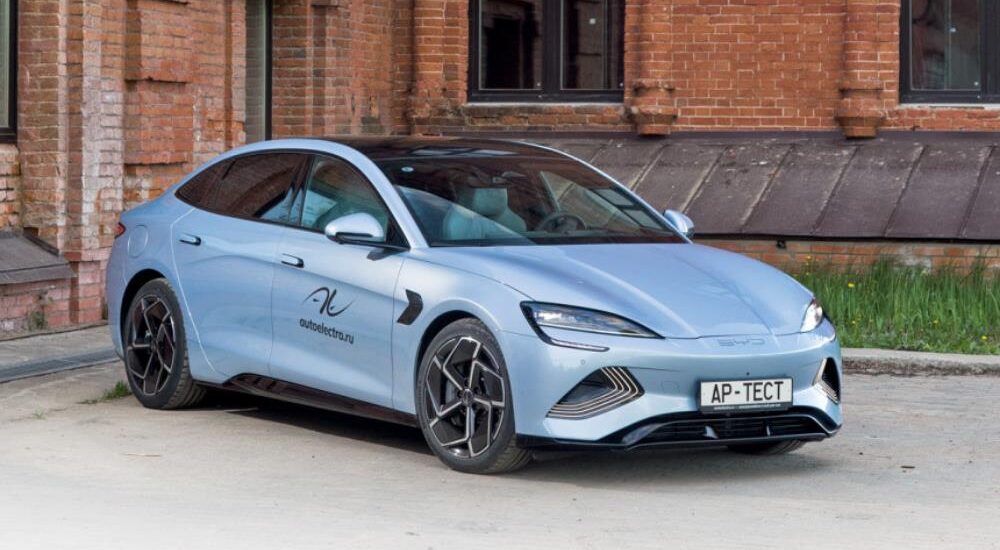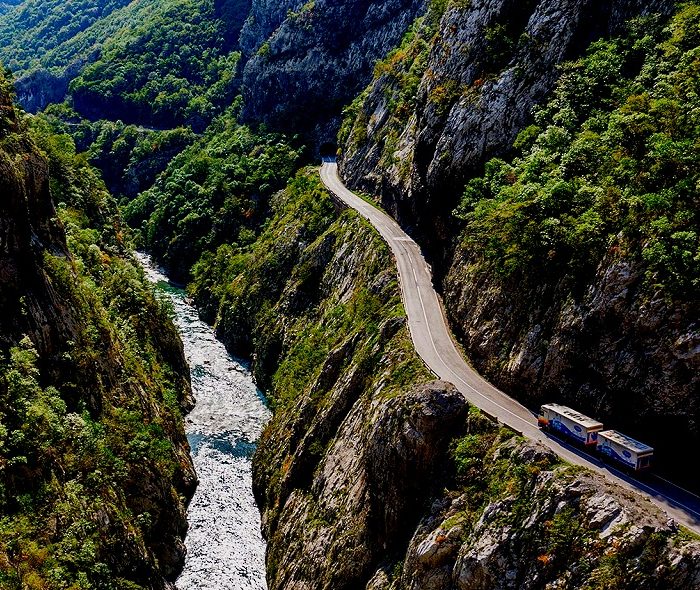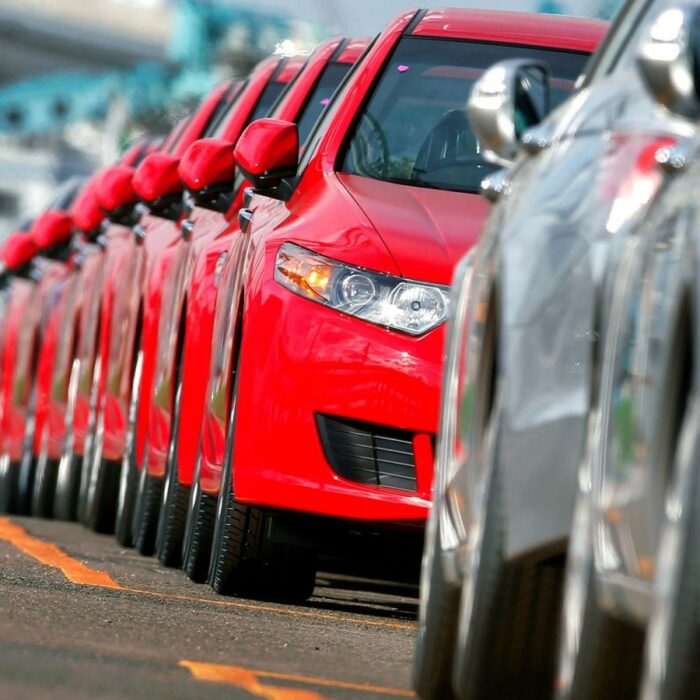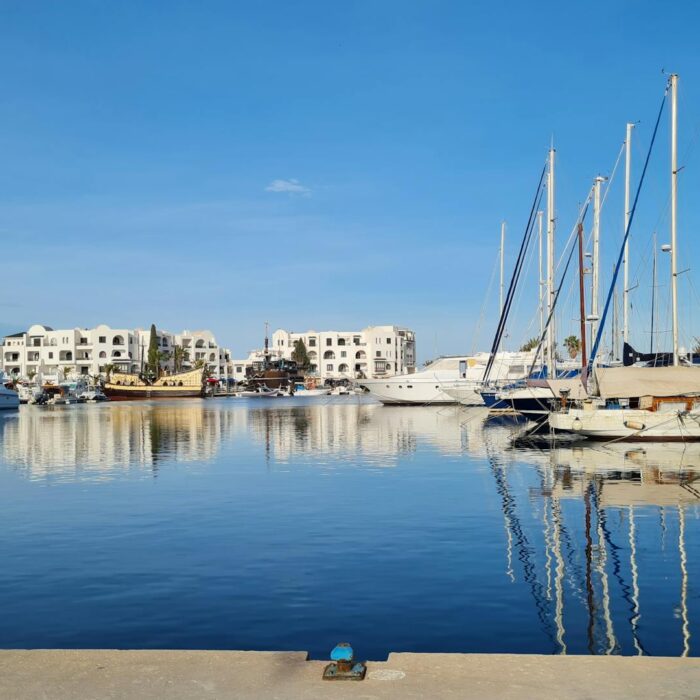Avec une charge complète de la batterie d’une capacité de 82,5 kWh, la berline électrique BYD Seal promet de parcourir une distance impressionnante de 650 km. Sur le couvercle du coffre, parmi les caractères, on distingue le chiffre 3.8, qui n’est autre que le temps d’accélération à 100 km/h. Le “phoque” chinois est-il vraiment si cool ?
Je le jure, c’est la plus belle voiture chinoise que j’ai eu le plaisir de conduire. Bravo, Wolfgang Egger ! Oui, c’est bien le même Egger qui a eu la chance de travailler chez Alfa Romeo et VW Group, et qui depuis 2017 dirige les designers de BYD.
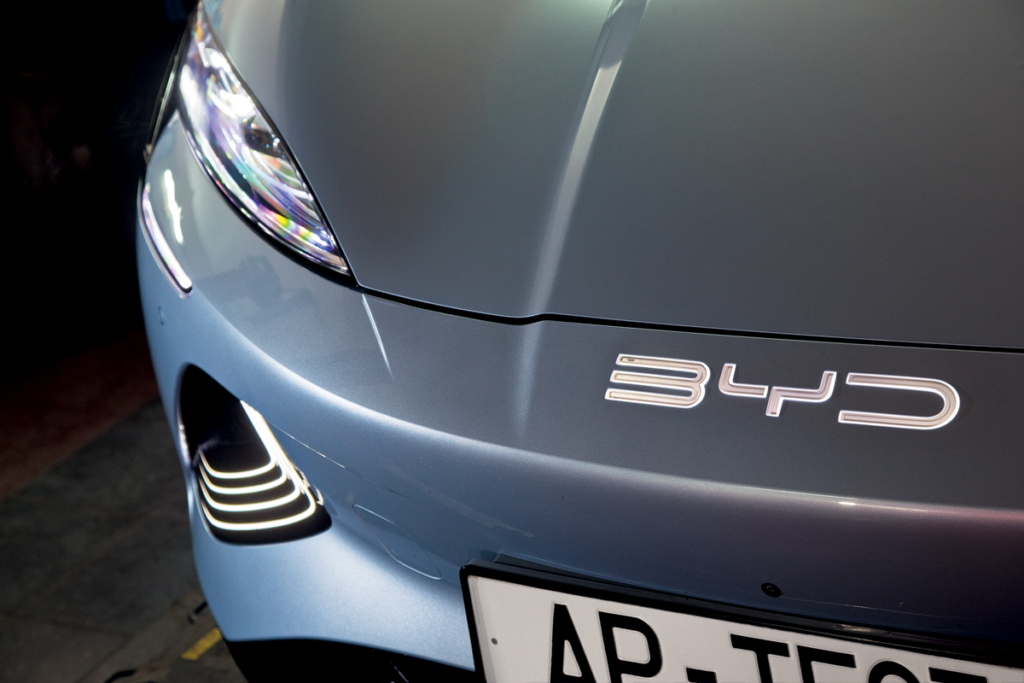
Les sections concentriques des feux de circulation sont frappantes, et l’emblème BYD ne s’allume que pendant quelques secondes lorsque les serrures sont activées.
Regardez de plus près ces “lignes de Faraday” aux angles du pare-chocs avant : elles évoquent à la fois les champs magnétiques d’induction, tels qu’ils sont généralement représentés dans les manuels de physique, et les motifs des coquillages. Les feux arrière, remplis de “pixels” de diodes électroluminescentes, sont également fascinants. On pourrait penser que la Seal n’est qu’une modification du design de la berline BYD Han EV que nous connaissons déjà, d’autant plus qu’elles ont le même empattement – 2920 mm. Cependant, alors que la Han est construite sur la plateforme DM3, qui permet également une version hybride, la Seal est une voiture électrique sans compromis, dotée d’une nouvelle architecture e-platform 3.0 de 800 volts et d’un système de suspension plus complexe. Par exemple, à l’arrière, il y a une cinématique sophistiquée avec cinq bras pour chaque roue.
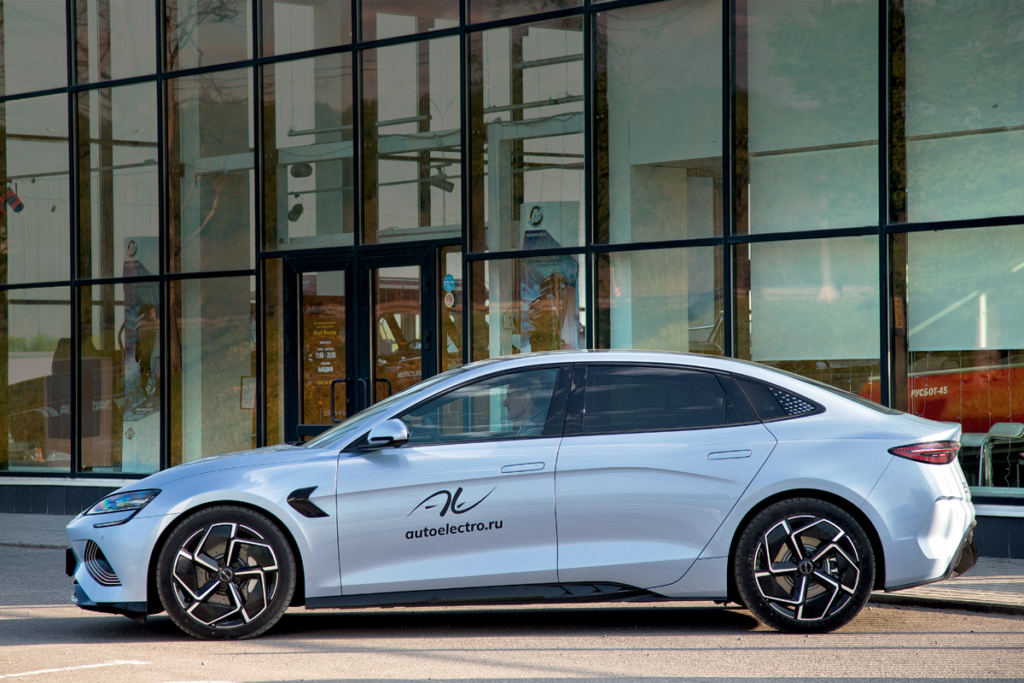
La silhouette est magnifique, mais la garde au sol est hasardeuse. Même sans charge, il y a 130 mm sous le châssis, et les spoilers en plastique devant les roues sont suspendus à 92 mm au-dessus du sol.
Mais la caractéristique principale de la construction est la batterie au lithium fer phosphate de la série Blade avec des éléments de puissance plats dans un boîtier robuste. Elle est intégrée à la structure de la carrosserie – c’est ce que l’on appelle l’architecture CTB (cell to body). En fait, Tesla est également en train de passer à un schéma similaire pour ses modèles 3 et Y, pour lesquels une batterie intégrée a été développée avec des cellules standard plus grandes, soit 4680 cellules au lieu des 2170 précédentes. Cela contribue à la sécurité active en abaissant le centre de gravité et à la sécurité passive – la Seal a obtenu le maximum de cinq étoiles dans la série de tests de collision C-NCAP en Chine.
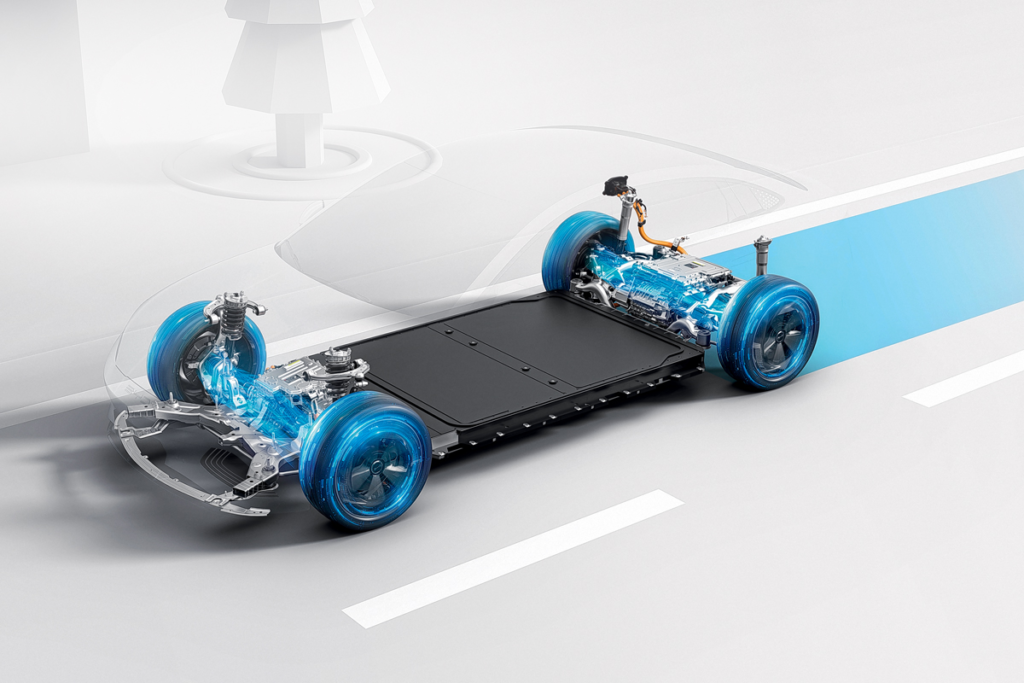
La disposition cellule-corps – la batterie dans un boîtier robuste est intégrée dans la structure de puissance de la carrosserie, ce qui se traduit par une rigidité torsionnelle impressionnante de 40 500 Nm/degré.
En outre, cette construction a permis d’abaisser les sièges de 10 mm, mais même après cela, on n’a pas l’impression d’être en position basse derrière le volant. La batterie a son épaisseur, qui ne peut être ignorée : même avec le siège abaissé au maximum, je peux voir le capot. Du point de vue de la visibilité, c’est même un plus. Le siège lui-même, avec un appui-tête intégré, est universel – le dossier semi-circulaire tient assez bien dans les virages, mais n’impose pas de renforts latéraux rigides. Les deux sièges avant sont équipés de commandes électriques, d’un chauffage complet et d’une ventilation, y compris pour le dossier.
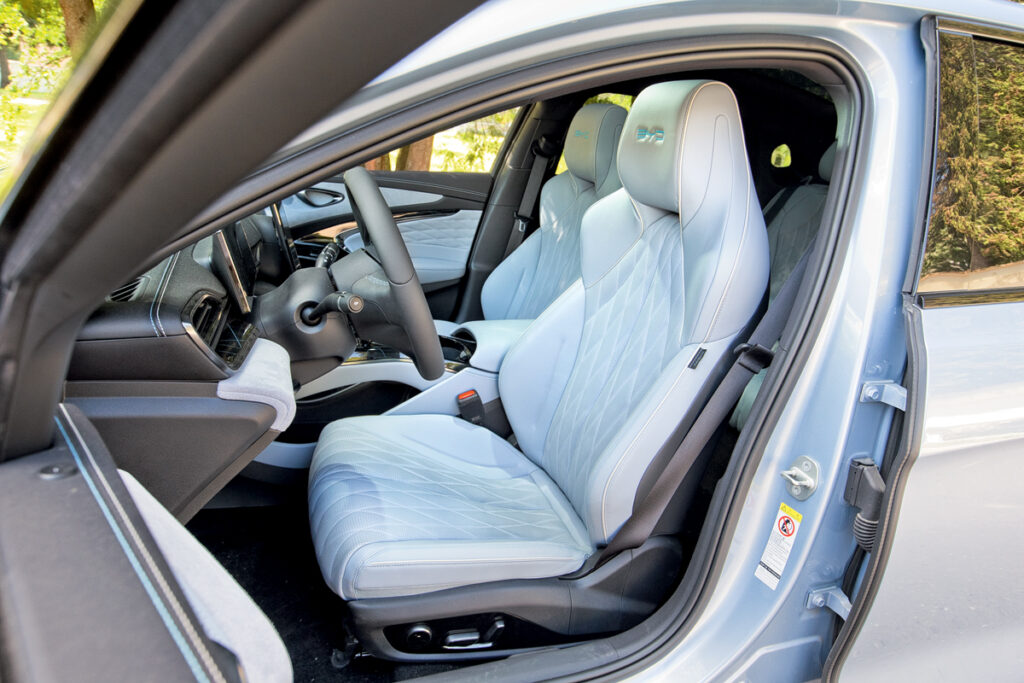
Le siège anatomique est d’un confort discret, avec des réglages électriques de l’angle du coussin d’assise et du soutien lombaire.
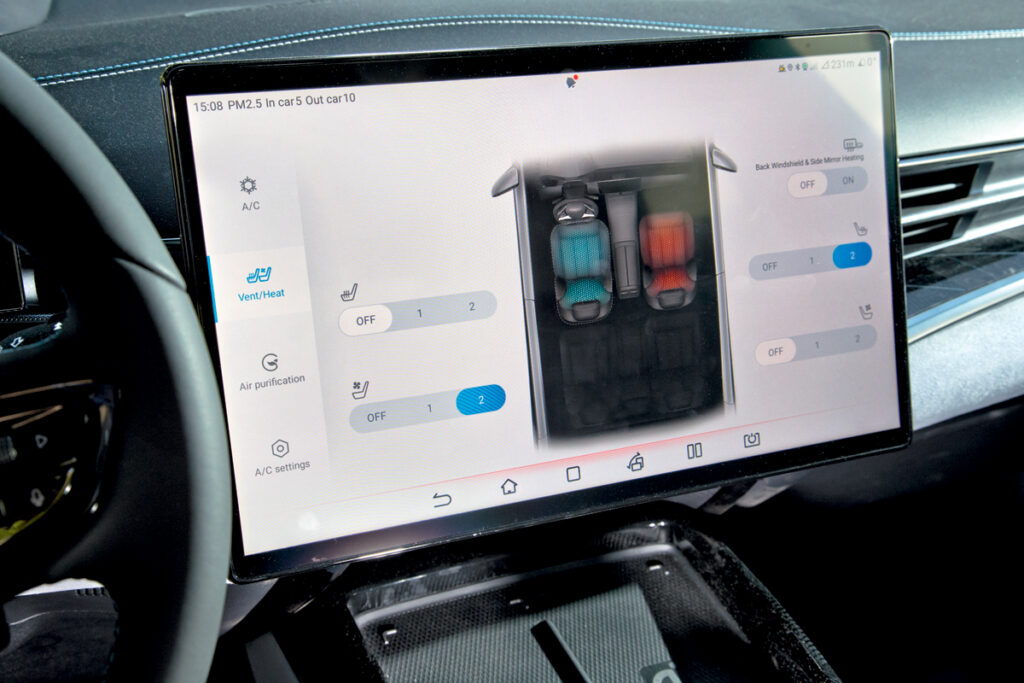
Le chauffage et la ventilation, qui peuvent être activés via le menu, couvrent toute la surface des sièges avant.
Le volant est doté de réglages mécaniques et d’une jante agréablement épaisse, avec une couture plate très soignée de la garniture en cuir. Les instruments sont bien sûr entièrement numériques, mais les options de design sont limitées – seulement deux. Toutefois, la version supérieure dispose d’un affichage tête haute. Au centre du tableau de bord se trouve bien sûr le “plat emblématique” de BYD, un énorme “téléviseur” pivotant d’une diagonale de 15,6 pouces. En outre, le système d’exploitation Android offre un excellent graphisme et permet d’installer facilement les applications russes les plus récentes.
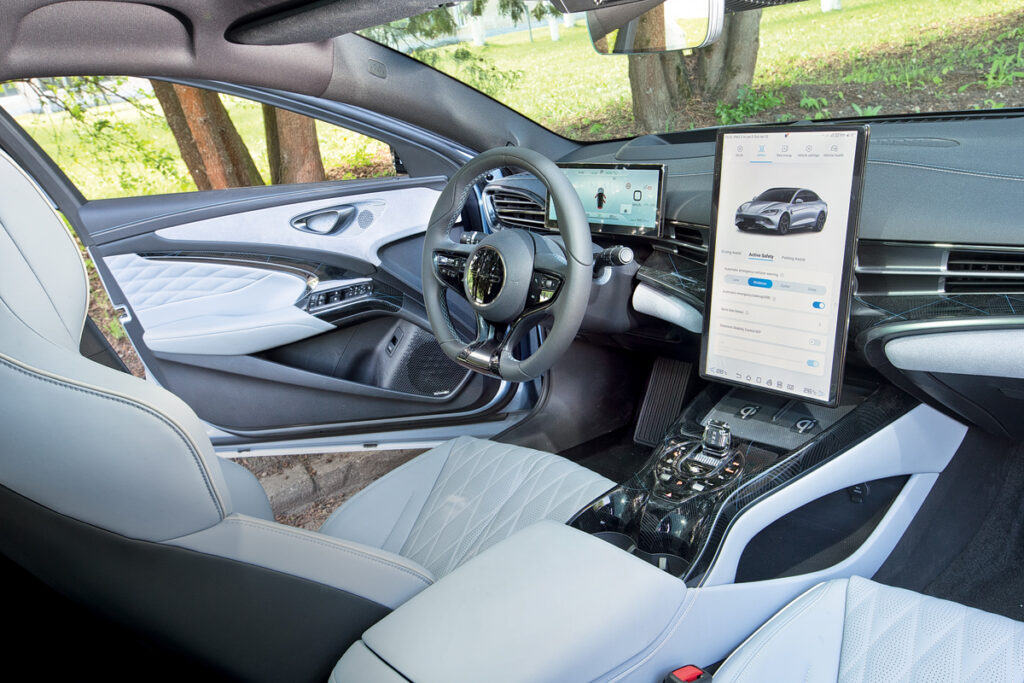
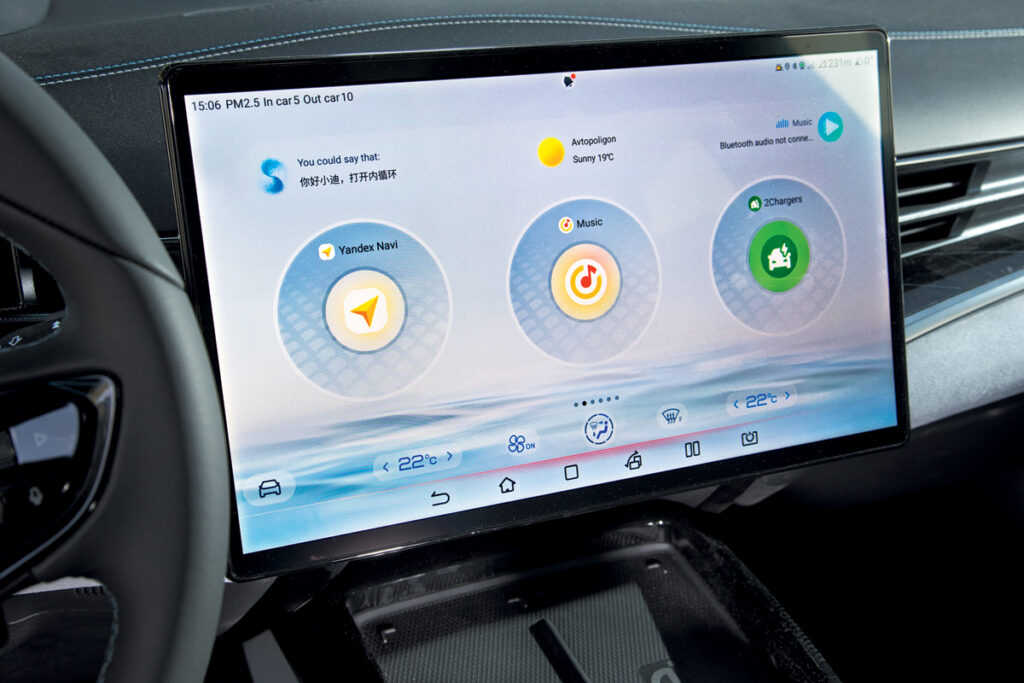
Au centre de la face avant se trouve un écran pivotant de 15,6 pouces, sous lequel se trouvent deux plaques de recharge par induction pour les smartphones
Et le contrôle entièrement électronique de la climatisation bizone. Les bouches d’aération astucieusement intégrées à la face avant n’ont pas de boutons – leur position ne peut être modifiée que par le biais du menu. Par exemple, en mode Avoid, les bouches d’aération élèvent le flux d’air vers le plafond, tandis que le mode Facing le dirige vers votre visage. C’est le mode Swing qui m’a le plus plu : dans ce mode, les bouches d’aération, comme dans les systèmes domestiques split, changent doucement la direction du flux d’air dans un cycle automatique.
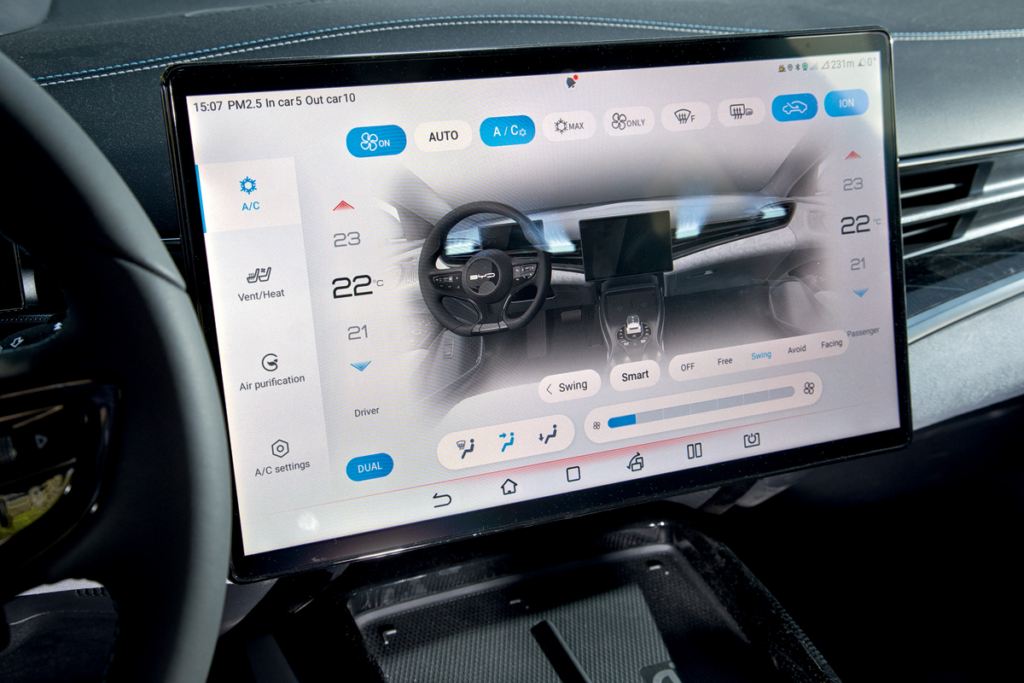
La gestion du contrôle du climat se fait par le menu. Vous pouvez régler chaque ventilation individuellement ou choisir l’un des programmes automatiques.
Malheureusement, parmi les touches de raccourci pour la climatisation, il n’y a pas d’activation de la recirculation. Le temps de naviguer dans le menu et de sélectionner l’icône appropriée, vous auriez déjà respiré des impuretés. Un mode de recirculation automatique résoudrait ce problème, mais au lieu de cela, le menu ne propose qu’une activation automatique du filtre à particules fines PM2.5.
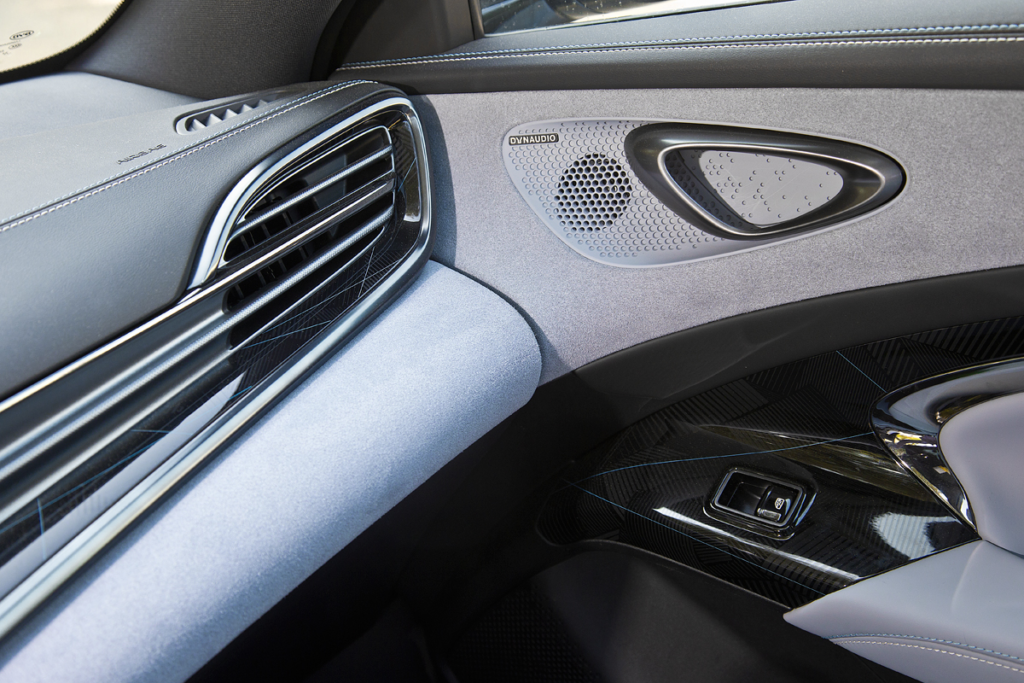
Quant à la finition de l’habitacle, il n’y a rien à redire : les plastiques souples, le cuir véritable ou artificiel sont omniprésents, et des inserts d’Alcantara bleu sont présents sur la face avant et les portières. Même les petits détails sont traités avec la minutie allemande : des revêtements en caoutchouc dans les creux des poignées de porte, dans les porte-gobelets, et des ports USB (USB-A et USB-C sont disponibles) avec éclairage des contours.
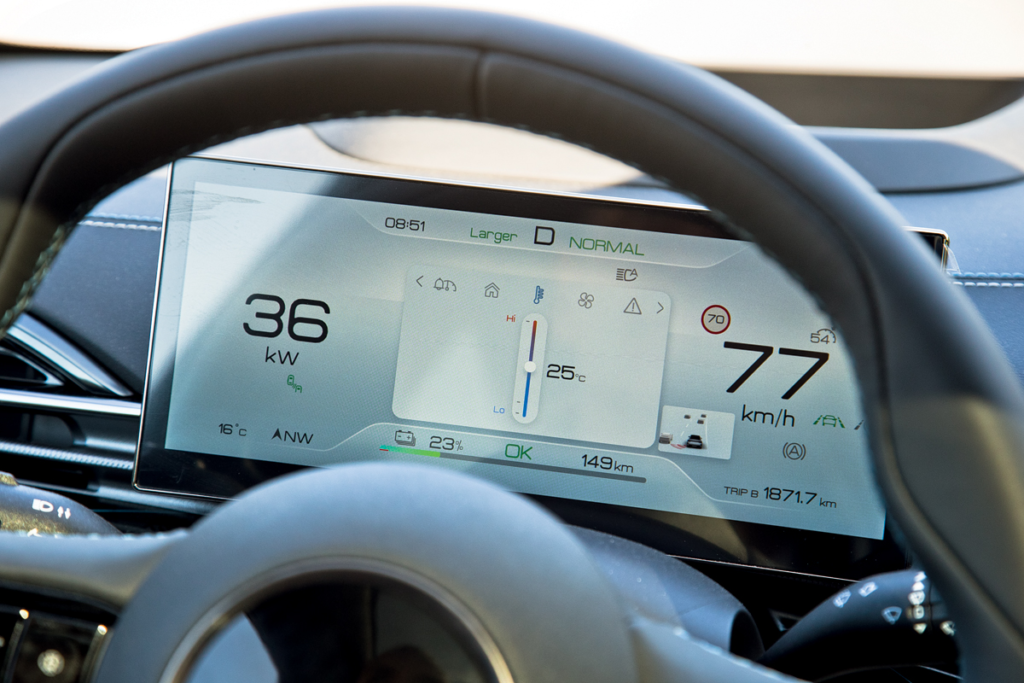
Différents paramètres peuvent être affichés sur l’écran du combiné d’instruments, y compris la température, qui peut ensuite être réglée à l’aide de boutons sur le volant.
Ce qui est le plus agréable aux places arrière, c’est la clarté du ciel : le toit panoramique s’étend presque jusqu’à la lunette arrière. Il y a également beaucoup d’espace pour les jambes – je suis assis “derrière moi” avec un écart de huit centimètres. En revanche, je n’ai pas trouvé de délices multimédias dans l’accoudoir, comme dans le Han – seulement des porte-gobelets. Mais la Seal est conçue ainsi – c’est plus une voiture pour le conducteur que pour les passagers. Il est donc temps de démarrer !
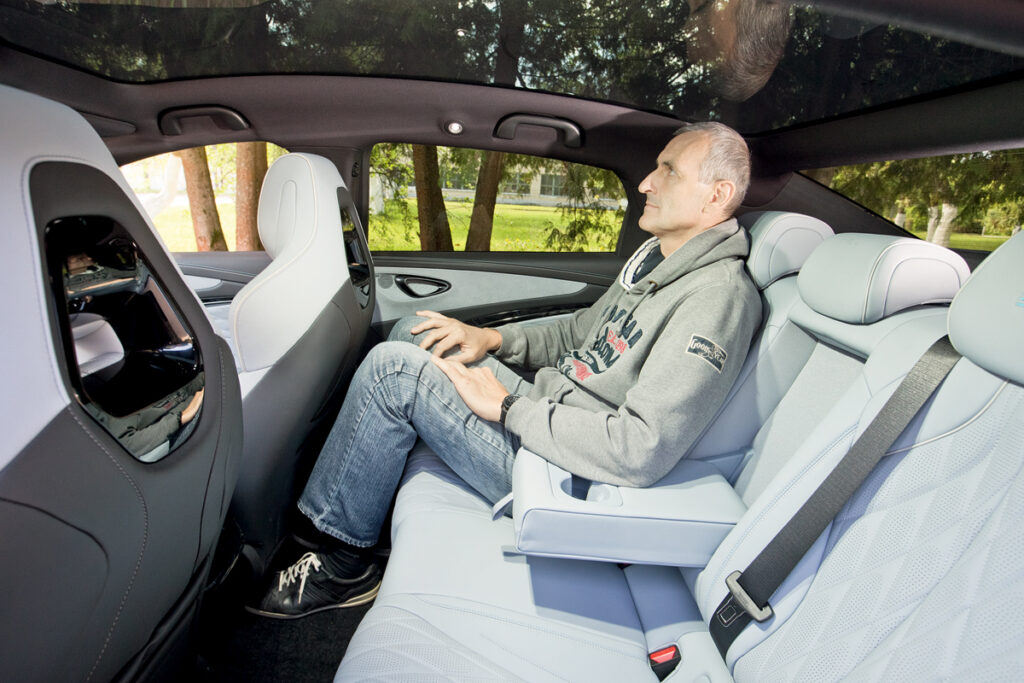
Il y a beaucoup d’espace pour les genoux, mais si le siège avant est complètement abaissé, il n’y a nulle part où poser les pieds.
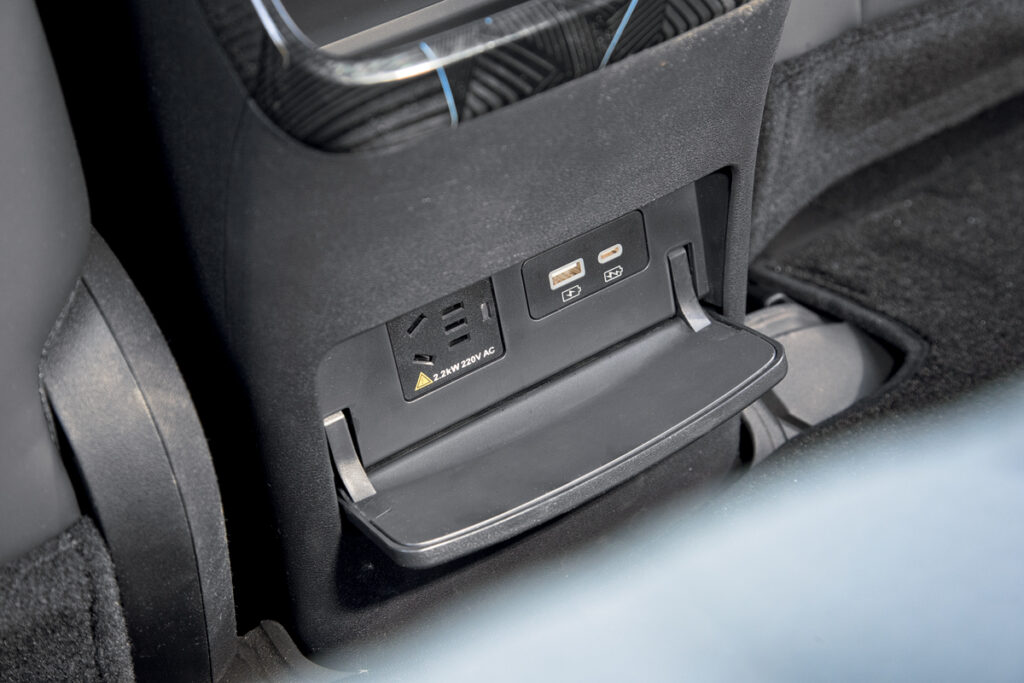
Au centre de la face avant se trouve un écran pivotant de 15,6 pouces, sous lequel se trouvent deux plaques de recharge à induction pour smartphones.
Pour passer en mode “drive”, il suffit de tirer brièvement sur le sélecteur de drapeau “crystal” – et vous pouvez commencer une accélération silencieuse. Je suis déjà préparé au fait que les voitures BYD sont finement réglées en termes de contrôle de l’accélérateur. Il n’y a pas d’à-coups, tout est fluide, mais très énergique.
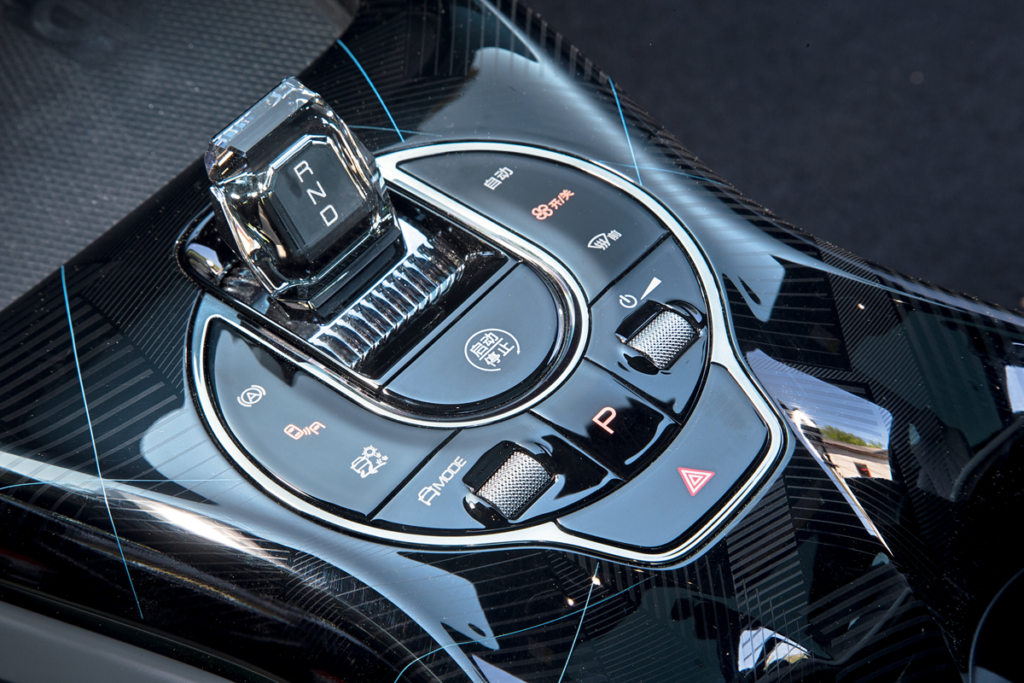
Le joystick de sélection “cristal” fonctionne sans délai. Le bouton semi-circulaire en bas est l’inclusion de l’allumage. Une clé de démarrage à distance est également fournie, ce qui permet de réchauffer l’habitacle avant le voyage.
Accélération jusqu’à 100 km/h ? La télémétrie embarquée indique les 3,8 secondes promises, mais notre appareil de mesure GPS VBox est plus réaliste : 4,13 secondes. Le BYD Han a lui aussi “arrondi” les résultats. Mais c’est pardonnable. Le pire, c’est qu’un tel résultat n’a pas pu être atteint lors d’accélérations répétées : à la troisième et à la quatrième tentative, le taux de gain de vitesse après 80 km/h a diminué, et le temps est passé à près de cinq secondes. La charge de la batterie n’a pas pu influer sur ce résultat : il y avait plus de 80 % d’électricité dans le “réservoir”. Il est donc très probable que l’électronique limite la puissance en fonction de certains algorithmes – peut-être en tenant compte de la température de la batterie ou des onduleurs. Cependant, la température extérieure était idéale pour les mesures (+19°C).
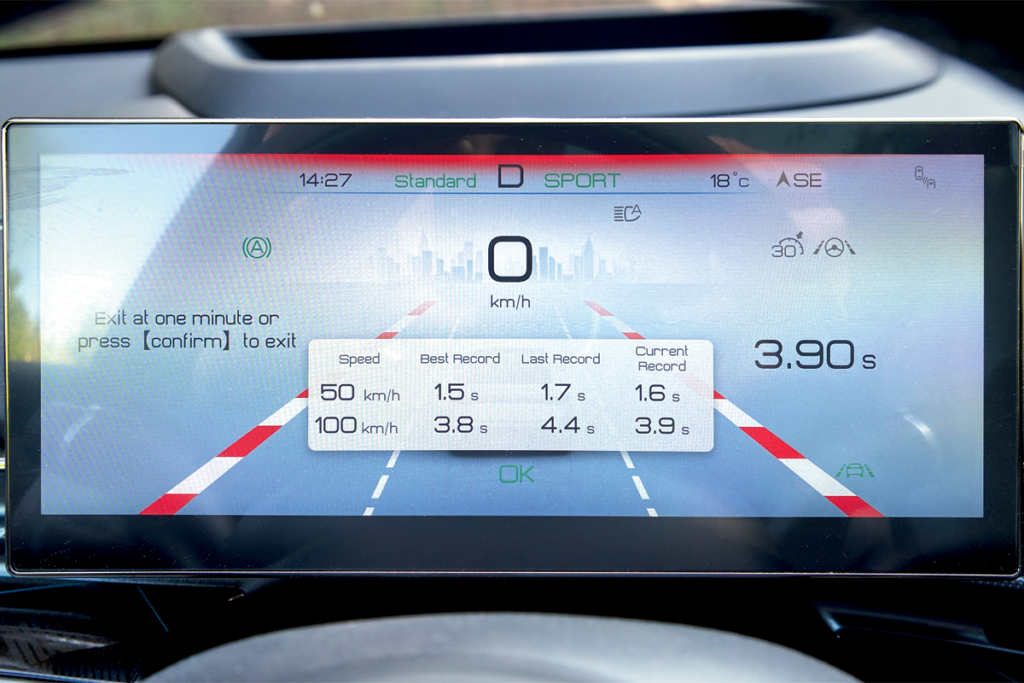
En mode Sport, il suffit de maintenir le bouton au volant pour que le mode télémétrique d’accélération s’affiche sur le tableau de bord : 3,8 secondes à l’écran, c’est 4,13 secondes en réalité.
Nous avons fait une pause, conduit en mode standard, répété l’accélération – cela n’a rien changé. De 0 à 100 km/h en 4,73 secondes. Il ne s’agit pas d’une Porsche Taycan 4S, qui atteint les 100 km/h en 4,1 secondes, mais cinq fois de suite, et accélère ensuite facilement jusqu’à 250 km/h. Mais pour la BYD Seal, même 124 mph (200 km/h) est inaccessible : il y a beaucoup de puissance (530 ch pour les deux moteurs électriques combinés !), mais le “limiteur” électronique coupe l’accélération à 118 mph (190 km/h).
Par ailleurs, les freins sont très efficaces : la lourde voiture électrique s’arrête à 100 km/h en 35,9 mètres. Et de 93 mph (150 km/h) en 265,7 pieds (81 mètres). Le mérite en revient également aux derniers pneus Continental SportContact 7 d’une dimension de 235/45 R19.
Quelques résultats de mesure :
Temps d’accélération
| Vitesse | L’heure |
|---|---|
| 0-50 km/h | 1,8 s |
| 0-100 km/h | 4,1 s |
| 0-150 km/h | 8,7 s |
| 60-100 km/h (D) | 1,9 s |
| 80-120 km/h (D) | 2,6 s |
| Vitesse maximale – 190 km/h |
Distances de freinage
| De | Distance | Décélération |
|---|---|---|
| 100 km/h (62 mph) | 35,9 m(117.8 ft) | 10,7 m/s² |
| 150 km/h (93 mph) | 81,0 m (265,7 ft) | 10,7 m/s² |
Cependant, les ambitions sportives s’arrêtent au freinage : la BYD Seal est loin d’être une Porsche en termes de tenue de route. Ni même une Volkswagen.
On pourrait penser qu’avec un centre de gravité aussi bas, une répartition des masses presque parfaite et une suspension arrière sophistiquée, la Seal devrait coller à l’asphalte dans les virages. Mais en roulant plus vite, on ressent la lourdeur, le roulis – et surtout, dans la plupart des virages, il faut ajuster la direction pour corriger la trajectoire. Il est difficile d’évaluer l’angle à l’entrée d’un virage et de passer toute la courbe sans ajustement supplémentaire de la direction : sous charge, le véhicule électrique passe à un rayon plus serré, et il faut dérouler la direction. La maniabilité manque également de réactivité.
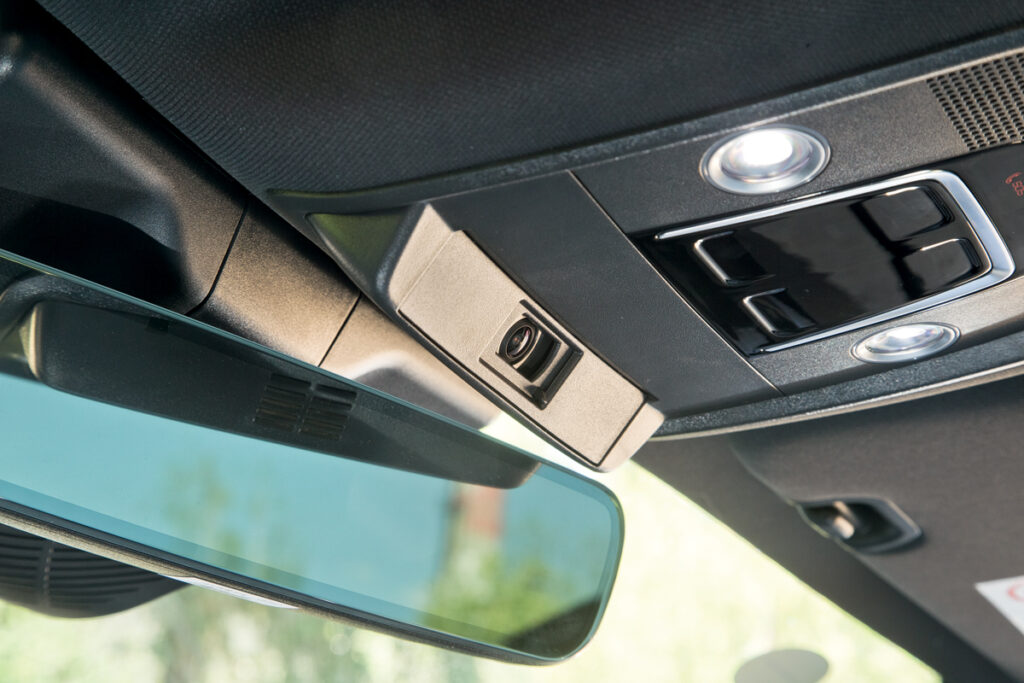
Sur la console de pavillon se trouve une unité de commande tactile typique de BYD pour l’éclairage et le toit ouvrant, que Seal n’a pas.
Il y a également une caméra de “suivi” pour les passagers arrière.
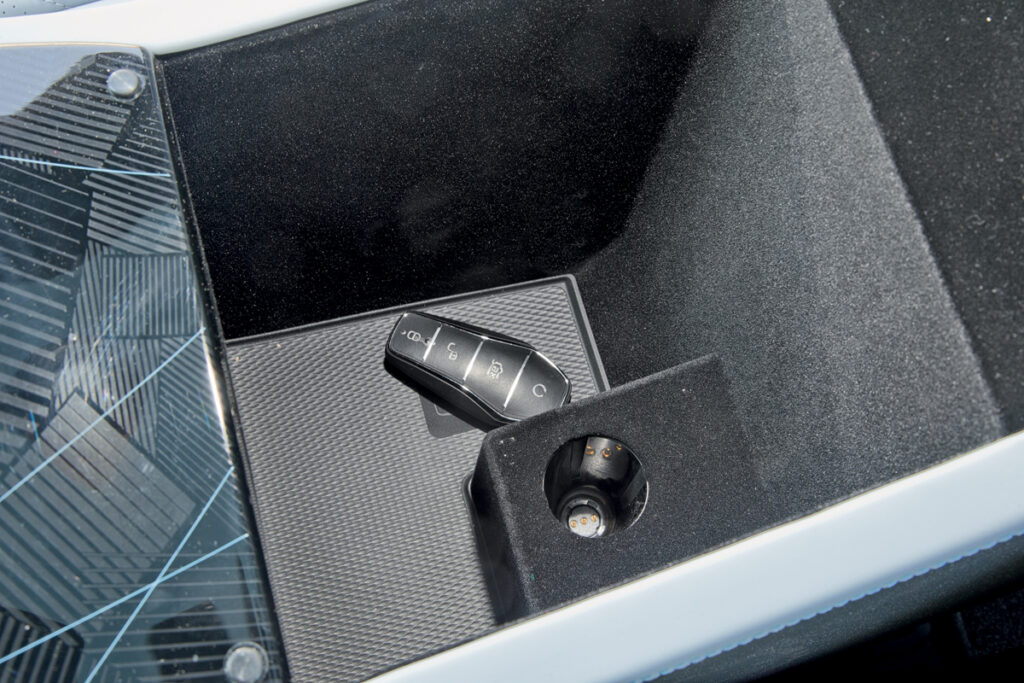
Dans le caisson de l’accoudoir se trouve une prise pour recharger… un microphone de karaoké !
Cependant, tous ces défauts ne sont perceptibles qu’en conduite agressive – en mode standard, la tenue de route est tout à fait raisonnable. Et sur une route droite, il n’y a pas de sensation d’acuité excessive. Ajoutez à cela une excellente douceur de roulement : la Seal absorbe très bien les petites bosses et, à grande vitesse, elle oscille même légèrement. De plus, l’isolation phonique est excellente (les portes avant sont équipées d’un double vitrage). Vous comprendrez alors que le Seal n’est pas conçu pour la course, mais pour une expérience de conduite détendue. Et c’est la bonne approche. En effet, la plupart des propriétaires de véhicules électriques conduisent en mode éco, prolongeant la charge de la batterie et utilisant le potentiel des moteurs à peine au tiers de la distance parcourue. Si vous appuyez de manière agressive sur l’accélérateur, la Seal consomme 37,4 kWh pour 100 km !
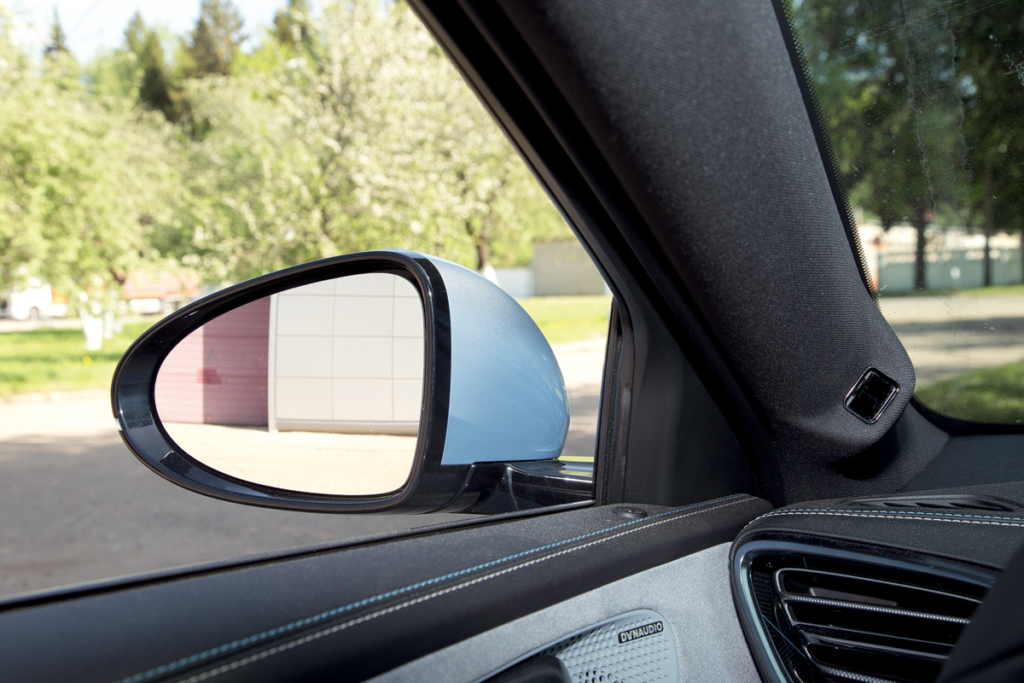
Les rétroviseurs extérieurs ne sont pas les plus grands, et l’œillet sur le montant gauche est une caméra de surveillance du conducteur, qui peut être recouverte d’un volet.
Qu’en est-il des modes standard ? Avec un passager et une batterie complètement chargée, au lieu des 404 miles (650 km) promis, la Seal a réussi à parcourir… 242 miles (390 km). De plus, BYD a limité la puissance sur les 15 derniers kilomètres : même en appuyant à fond sur la pédale, la puissance n’a pas dépassé 16 kW selon le wattmètre, et la vitesse – 43 miles par heure (70 km/h). L’algorithme pour atteindre la destination est le même que sur le crossover BYD Yuan Plus.
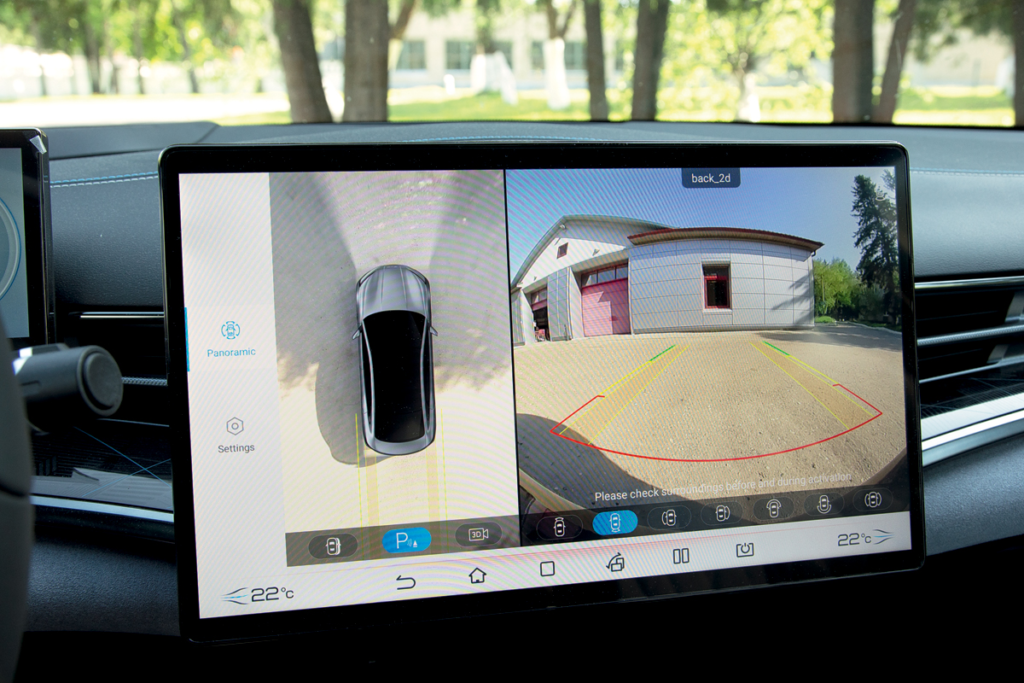
Le grand écran affiche une image de haute qualité provenant des caméras de surveillance avec sélection de l’angle de vue.
Point positif, après avoir complètement vidé la batterie, la Seal a commencé à se recharger sans problème à partir d’une borne de courant continu rapide. Heureusement, le terrain d’essai de Dmitrovskoye dispose désormais d’une telle borne, équipée d’un connecteur GB/T, compatible avec les véhicules électriques chinois. La station peut délivrer jusqu’à 120 kW, et le réseau de bord de la voiture est capable d’accepter jusqu’à 150 kW, mais pendant la charge, la puissance a fluctué autour de 82-88 kW, ce qui n’est pas si mal. À la fin du “ravitaillement”, les chiffres sur l’écran ont commencé à diminuer : d’abord à 40, puis à 20 kW – au final, la charge de la batterie de 0 à 100 % a duré 1 heure et 10 minutes.
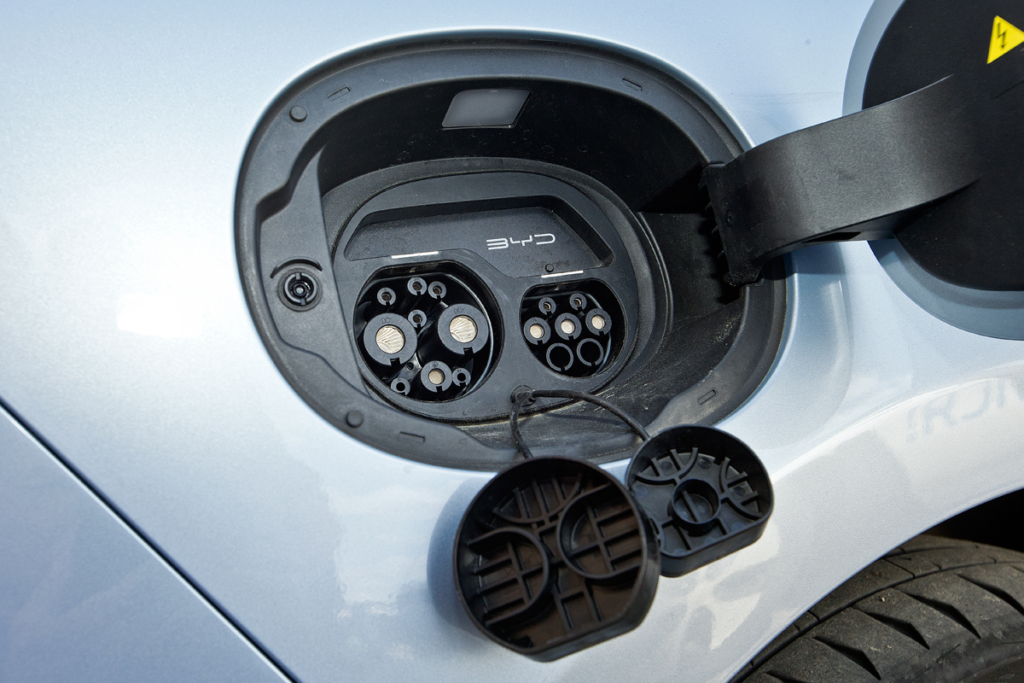
J’ai également essayé de charger le véhicule à l’aide d’une borne d’alimentation en courant alternatif. Tout fonctionne, mais la Seal, comme les autres voitures électriques chinoises, n’utilise qu’une seule phase sur trois, de sorte que la puissance de charge ne dépasse pas 7 kW.
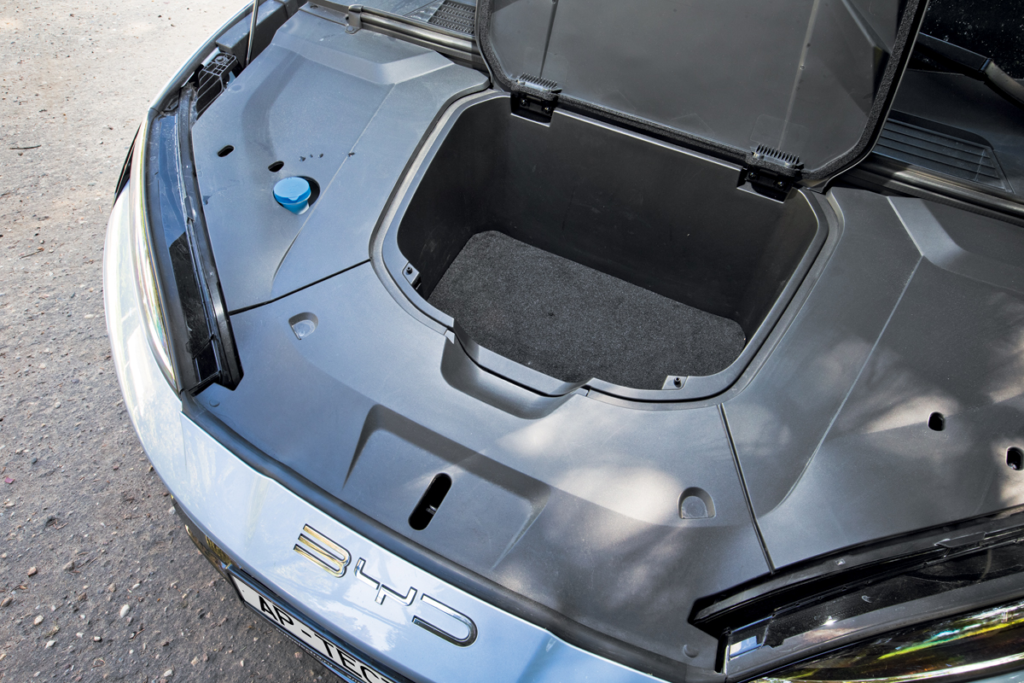
Le capot est monté sur des vérins à gaz, et sous le capot, il y a un coffre avant supplémentaire d’un volume de 53 litres.
En conclusion, compte tenu du prix – cette version haut de gamme à transmission intégrale coûte 5,3 millions de roubles chez Autoelectro, la société qui nous a fourni la voiture pour l’essai – il s’agit d’une alternative intéressante à la Tesla. Et l’absence de ventes officielles joue même en sa faveur : la BYD Seal restera exclusive dans un avenir prévisible, ne risquant pas d’être vue dans tous les quartiers d’ici un an.
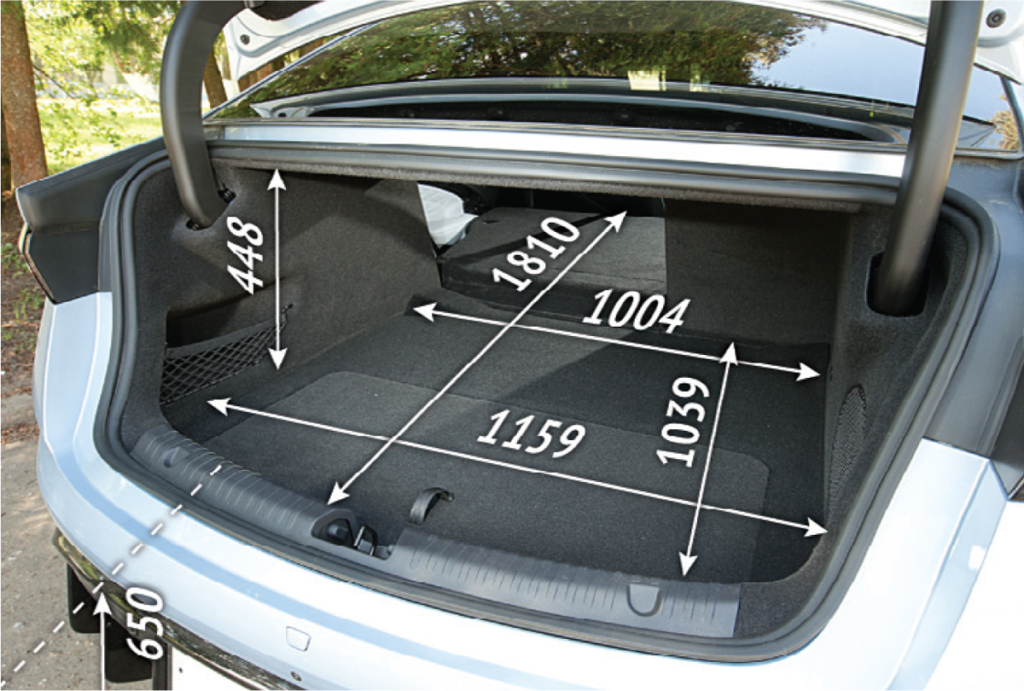
Le coffre principal n’est pas très grand, mais il dispose d’un sous-plancher et d’un “sous-sous-plancher” contenant des outils et du mastic pour pneus au lieu d’une roue de secours (les dimensions sont exprimées en millimètres).
L’achat d’une voiture sans garantie officielle est, bien sûr, préoccupant. Mais Autoelectro est prêt à fournir des pièces de rechange dans un délai d’un mois. Par exemple, la jupe du pare-chocs avant a été endommagée pendant le transport sur la voiture d’essai (ce qui n’est pas surprenant, vu le porte-à-faux et la garde au sol de 130 mm). Mais la pièce a déjà été commandée et sera bientôt à Moscou.
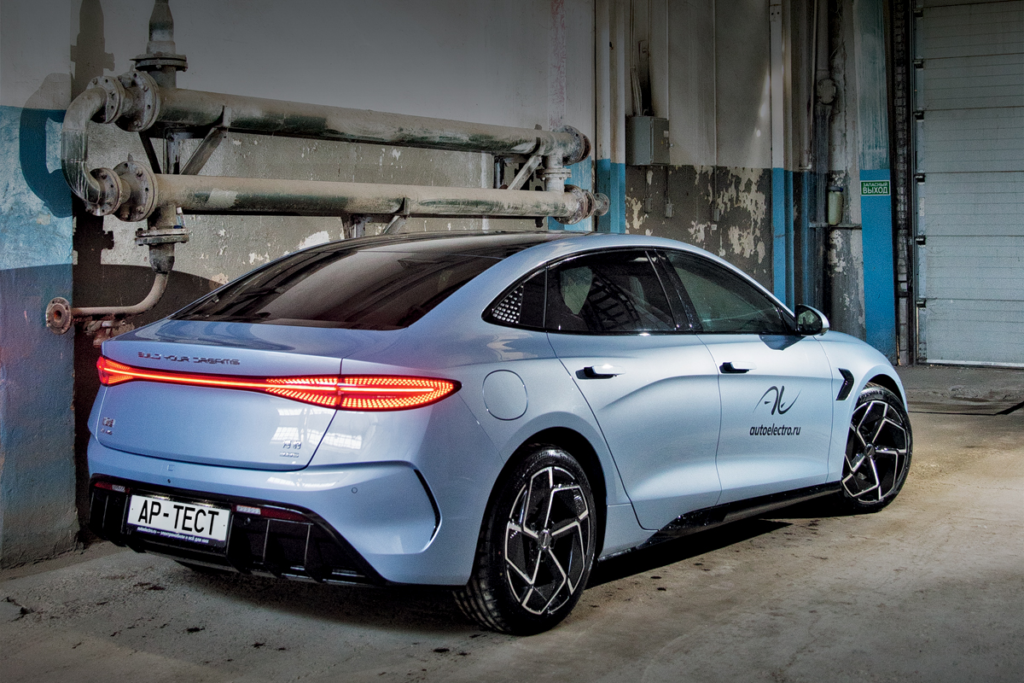
Le diffuseur arrière contribue à réduire le coefficient de traînée à un niveau exceptionnel de 0,219.
En Chine, la Seal est garantie six ans ou 150 000 kilomètres. D’ailleurs, la version de base à traction arrière de 204 ch coûte là-bas 189 800 yuans (environ 2,2 millions de roubles), soit 18 % moins cher qu’une Tesla Model 3 comparable. La version à double moteur et à transmission intégrale Seal de 530 ch coûte 279 800 yuans, soit 16 % de moins. C’est le résultat de la guerre des prix dont Sergey Znaemsky a parlé : après que Tesla a commencé à casser les prix, BYD a fait une contre-attaque. Après tout, au cours du premier trimestre de cette année, 42 782 berlines Tesla Model 3 ont été vendues en Chine, tandis que 19 573 acheteurs ont choisi la BYD Seal.
Dimensions, poids et répartition du poids le long des axes

Poids réel du véhicule sans conducteur – 2207 kg.
Les données du fabricant sont surlignées en bleu/les mesures d’Autoreview sont surlignées en noir. Les dimensions sont en millimètres.
**Largeur intérieure au niveau des épaules de la première/de la deuxième rangée de sièges.
Photo : Dmitry Pitersky Dmitry Pitersky
Groupe d’experts : Andrey Mokhov
Il s’agit d’une traduction. Vous pouvez lire l’article original ici : BYD Seal и 530 сил : наш тест и замеры на полигоне

Publié Juillet 12, 2023 • 13m à lire

